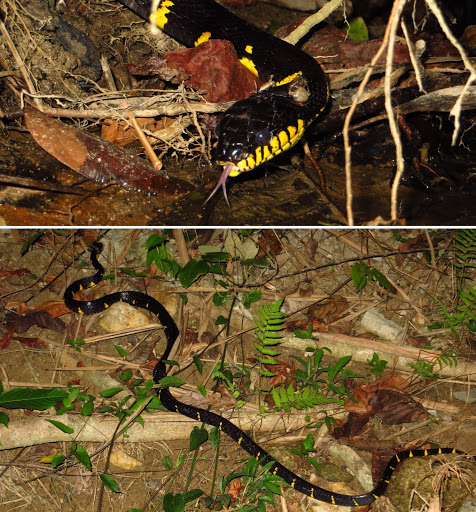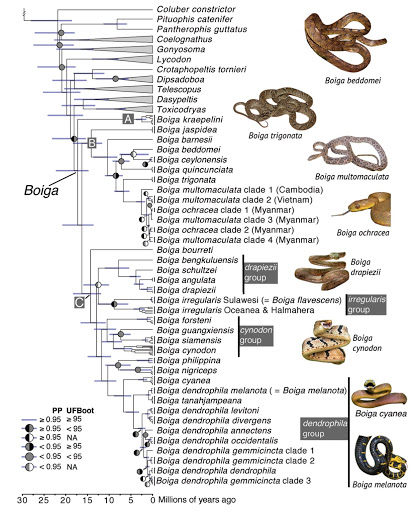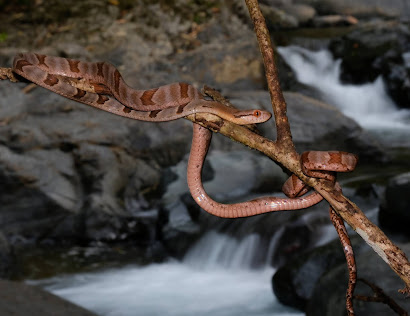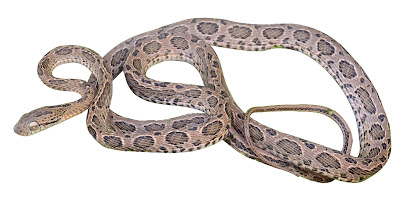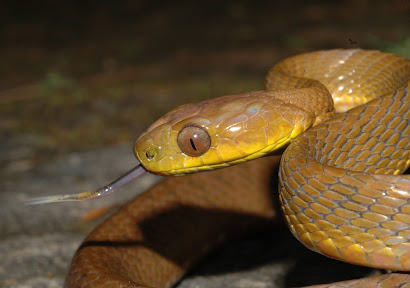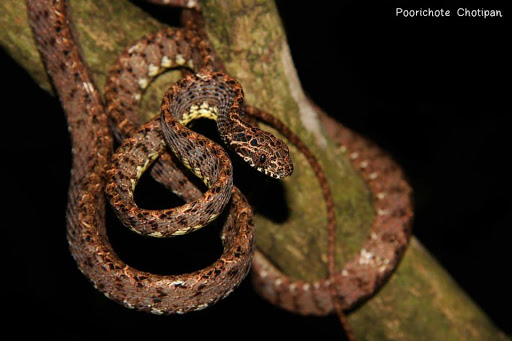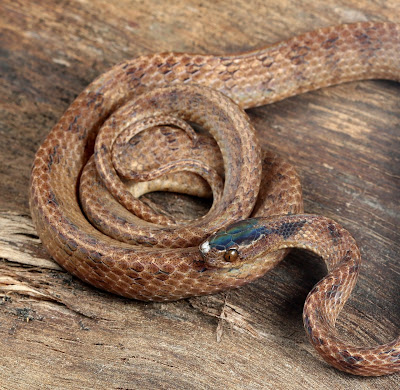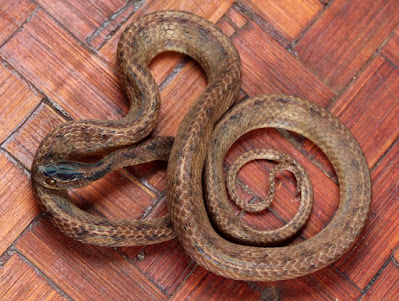[Most Recent Entries] [Calendar View]
Saturday, December 19th, 2020
| Time | Event | ||||||||||||
| 9:09a | [Herpetology • 2020] Phylogenetic Relationships and Biogeographic Range Evolution in Cat-eyed Snakes, Boiga (Serpentes: Colubridae)
Abstract The genus Boiga includes 35, primarily arboreal snake species distributed from the Middle East to Australia and many islands in the western Pacific, with particularly high species diversity in South-East Asia. Despite including the iconic mangrove snakes (Boiga dendrophila complex) and the brown tree snake (Boiga irregularis; infamous for avian extinctions on small islands of the Pacific), species-level phylogenetic relationships and the biogeographic history of this ecologically and morphologically distinct clade are poorly understood. In this study, we sequenced mitochondrial and nuclear DNA for 24 Boiga species and used these data to estimate a robust phylogenetic inference, in order to (1) test the hypothesis that Boiga is monophyletic, (2) evaluate the validity of current species-level taxonomy and (3) examine whether geographic range evolution in Boiga is consistent with expectations concerning dispersal and colonization of vertebrates between continents and islands. Our results support the prevailing view that most dispersal events are downstream – from continents to oceanic islands – but we also identify a role for upstream dispersal from oceanic islands to continents. Additionally, the novel phylogeny of Boiga presented here is informative for updating species-level taxonomy within the genus. Keywords: Boiga flavescens, Boiga multomaculata, Boiga dendrophila, dispersal, Philippines, South-East Asia, Sundaland, systematics, Wallace’s Line, Weber’s Line
Jeffrey L. Weinell, Anthony J. Barley, Cameron D. Siler, Nikolai L. Orlov, Natalia B. Ananjeva, Jamie R. Oaks, Frank T. Burbrink and Rafe M. Brown. 2020. Phylogenetic Relationships and Biogeographic Range Evolution in Cat-eyed Snakes, Boiga (Serpentes: Colubridae). Zoological Journal of the Linnean Society. zlaa090. DOI: 10.1093/zoolinnean/zlaa090 | ||||||||||||
| 9:34a | [Herpetology • 2020] Pareas kaduri • A New Species of Snail-eating Snakes of the Genus Pareas Wagler, 1830 (Reptilia: Serpentes) from eastern Himalayas, India
ABSTRACT A new species of snail-eating snakes of the genus Pareas Wagler, 1830 is described from the eastern Himalayas. The species Pareas kaduri sp. nov. differs from all known species of the genus in bearing the following suite of characters: SVL 455–550 mm, TaL/TL 0.184–0.207, brown dorsum with black transverse bands throughout the body, 15 dorsal scale rows throughout the body and mid-dorsal vertebral scale rows enlarged, 8 rows keeled in males, loreal not touching orbit, ventrals 160–183, subcaudals 65–70 in males, 52 in one female specimen, hemipenis short, unilobed and 6–7 maxillary teeth. Molecular data for mitochondrial 16S rRNA and cytochrome b genes further attest the distinctness of the new species, which was recovered as a member of the Pareas hamptoni clade. Our work brings the total number of species recognized within the genus Pareas to 20. Keywords: Arunachal Pradesh, biodiversity hotspot, cyt b, Indo-Burma, molecular phylogeny, Pareidae, Pareas kaduri sp. nov., taxonomy
Class Reptilia Laurenti, 1768 Order Squamata Oppel, 1811 Suborder Serpentes Linnaeus, 1758 Family Pareidae Romer, 1956 Subfamily Pareinae Romer, 1956 Genus Pareas Wagler, 1830 Pareas kaduri sp. nov. Differential diagnosis: A new species of Pareas bearing the following suite of characters: (1) SVL 455–550 mm, (2) TaL/TL 0.184–0.207, (3) 15 dorsal scale rows (DSR) throughout body and mid-dorsal vertebral scale rows enlarged, 8 rows keeled in males, (4) loreal not touching orbit, (5) ventrals 160–183, (6) subcaudals 65–70 in males, 52 in one female specimen, (7) hemipenis short, unilobed, (8) 6–7 maxillary teeth, (9) dorsum brown with thin black transverse bands, the head with a large black blotch from which two longitudinal black stripes (3–4 scales wide) run on each side of the neck leaving a pale central portion. Etymology: The specific epithet is a patronym honoring wildlife photographer Sandesh Kadur for his contribution to biodiversity documentation in the Himalayas, in particular Arunachal Pradesh, as well as for his constant support to the authors during the expedition. Harshal Bhosale, Pushkar Phansalkar, Mandar Sawant, Gaurang Gowande, Harshil Patel and Zeeshan A. Mirza. 2020. A New Species of Snail-eating Snakes of the Genus Pareas Wagler, 1830 (Reptilia: Serpentes) from eastern Himalayas, India. European Journal of Taxonomy. 729(1), 54–73. DOI: 10.5852/ejt.2020.729.1191 twitter.com/snakeszeeshan/status/1339820101663563776 @SandeshKadur  |
| << Previous Day |
2020/12/19 [Calendar] |
Next Day >> |
